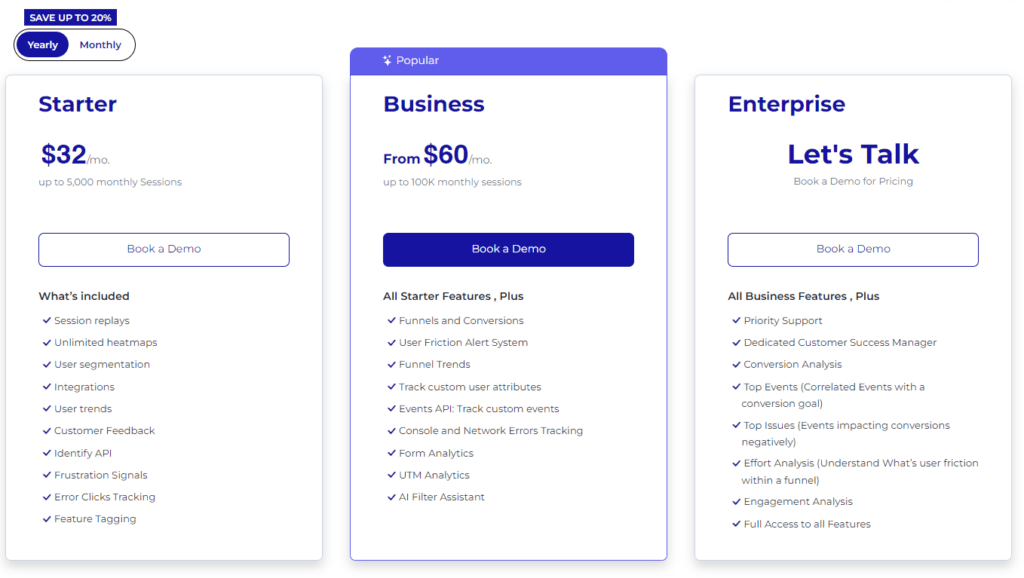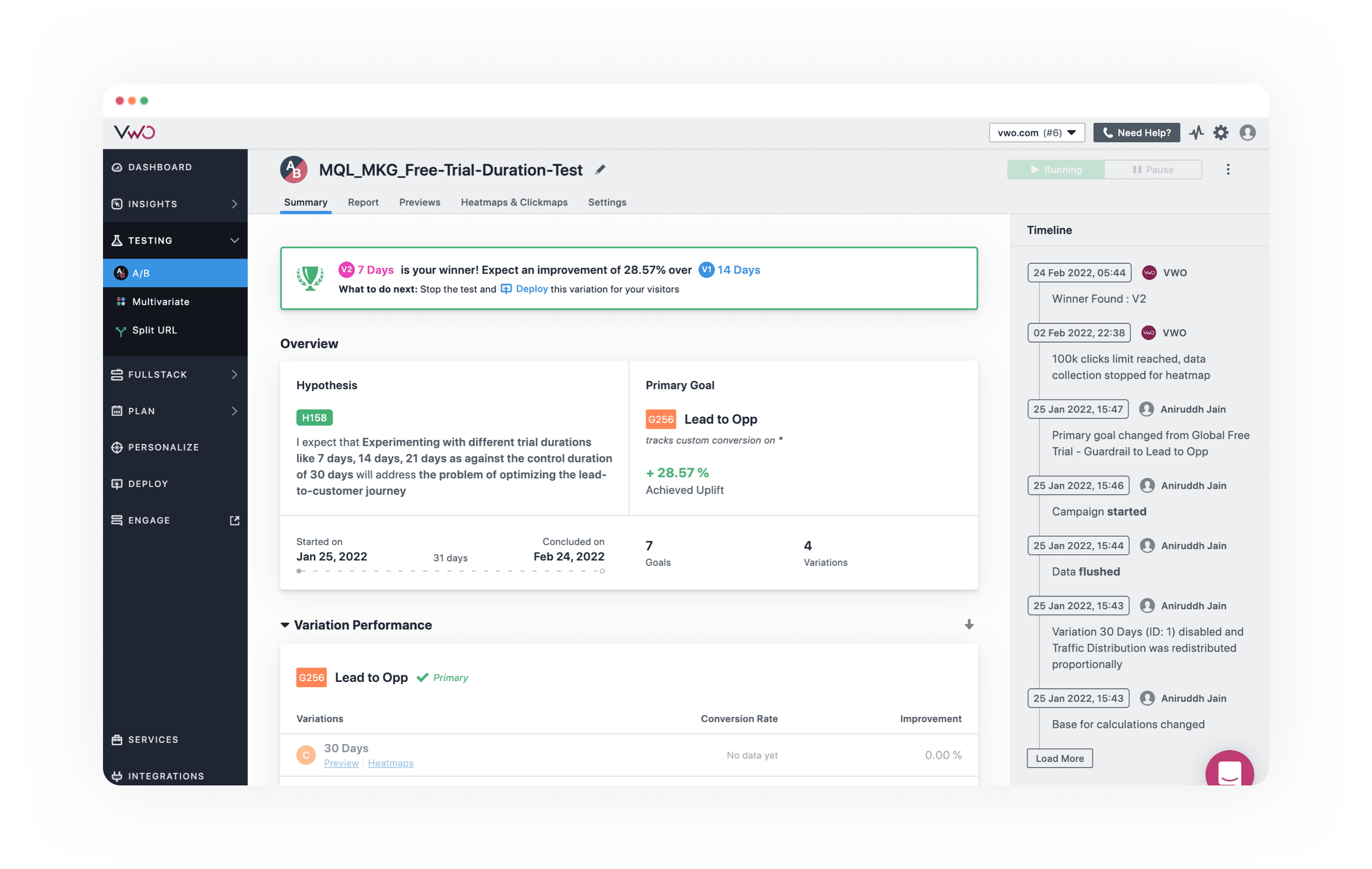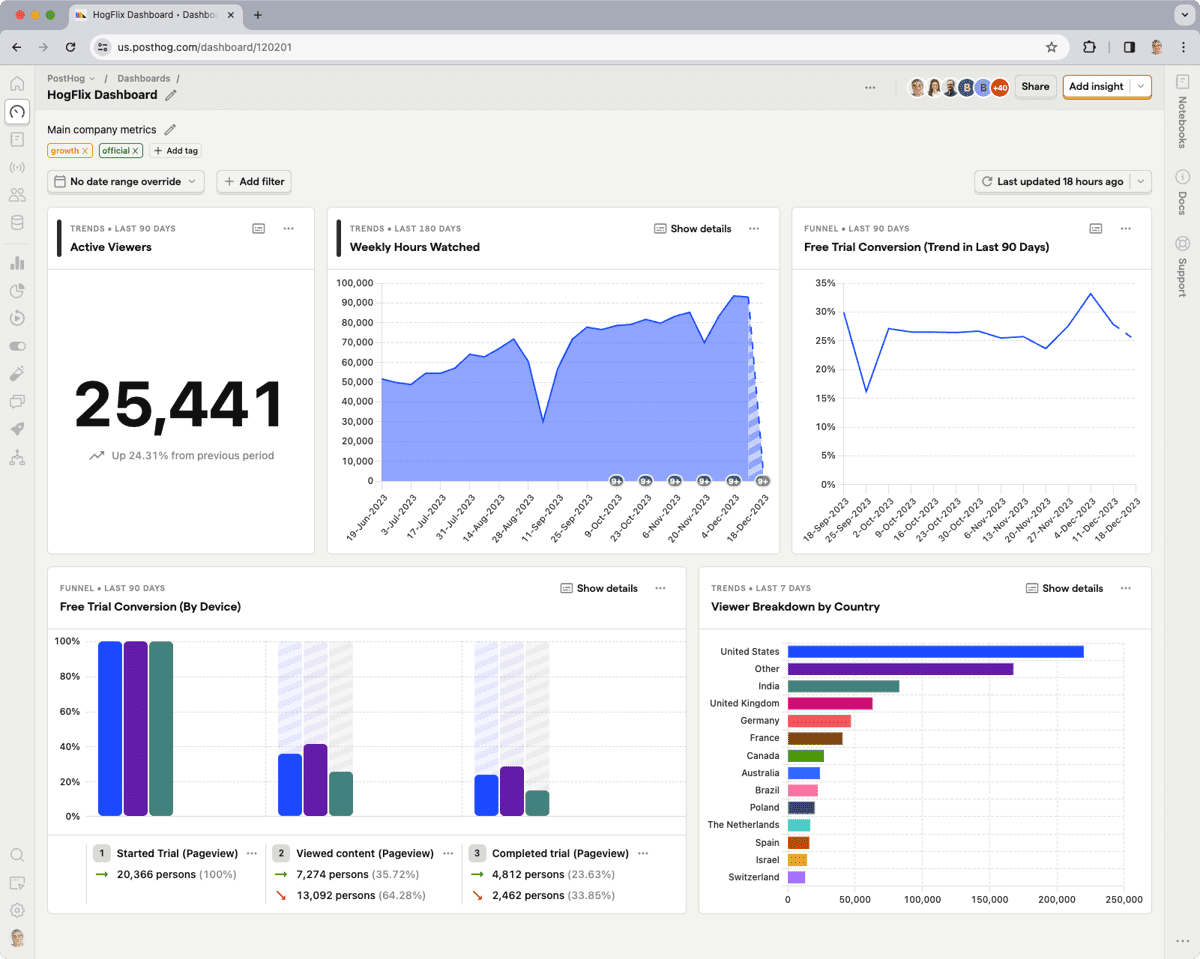Are you looking to optimize your website's performance but unsure if VWO is the right choice? You're in luck! We've compiled...

A Step-by-Step Guide to Customer Feedback Management
How you manage customer feedback will dictate how well you can meet customer expectations and increase their overall satisfaction. However, effective customer feedback management is more than just collecting data and responding to what your audience says.
You need an effective customer feedback management system that will ultimately lead to better customer retention and satisfaction. But how can you create such a process?
Let's explore customer feedback management, what it includes, why it's important, and how you can create your own system that works.
What is Customer Feedback Management?
Customer Feedback Management (CFM) is a way for businesses to collect, sort through, and make sense of feedback from folks who use their products or services.
Think of it as having a continuous conversation with your customers, where they tell you what’s great, what could be better, and sometimes, what just isn’t cutting it. By doing this, you can figure out what needs fixing or changing to keep your customers happy and coming back for more.
The Customer Feedback Loop
The customer feedback loop is the center of effective customer feedback management, and it revolves around a simple yet effective idea: continually engaging with your customers to improve their experience. Here’s what a basic loop looks like:
- Ask for feedback: Proactively reach out to gather opinions and actionable insights via customer satisfaction surveys (CSAT), customer effort score (CES), net promoter score (NPS), and other tools.
- Analyze the feedback: Dig into the responses to identify patterns, issues, and opportunities for improvement.
- Act on the insights: Implement changes based on what you've learned to improve products, services, or the entire customer journey overall.
- Inform your customers: Let your customers know what actions you've taken in response to their feedback to close the loop and encourage ongoing communication.
Why Is Customer Feedback Management Important?
An effective feedback management process helps you optimize the customer experience, which will eventually lead into other benefits for your business. Let's take a closer look at how CFM can benefit your business:
Keeps Your Business Relevant
CFM serves as a real-time gauge of market trends and customer desires, which works almost like a continuous health check for your business. When you keep up with this direct feedback, you can tweak and tailor your offerings to match the latest trends and customer cravings.
Updating what you sell based on what people are saying makes sure your products or services don’t get left behind. This is especially important in industries that are always on the move, where yesterday’s hot ticket can be today’s old news.
Plus, paying attention to this feedback can spotlight opportunities you might have missed—like a gap in the market that your business is perfectly poised to fill.
Improves Customer Satisfaction and Loyalty
Listening to your customers and actually acting on what they tell you is a major win for any business. When people see that you're not only hearing them but also making changes based on their feedback, it ramps up their satisfaction.
They feel like they have a direct impact on how you do things, which can turn a casual customer into a loyal fan.
And when customers are happy and feel connected to your business, they’re much more likely to stick around for the long haul. They become your cheerleaders, spreading the word about their great experiences.
This word-of-mouth can be incredibly beneficial, as new customers often trust recommendations from friends and family over any advertising.
Increases Business Revenue
Actively managing and responding to customer feedback really pays off when it comes to your revenue. When you improve your products and services based on what your customers say, you make what you're offering more attractive.
This approach leads to more sales because customers find just what they need with you, so they're less likely to shop elsewhere.
Happy customers are also big spenders. When they feel heard and valued, they connect more with your brand. So, they come back more often and spend more each time. They're also more open to checking out other things you offer because they trust you to deliver.
Minimizes Risks in Product Development
Using customer feedback collection tools in your product development process can help you dodge some common pitfalls. When you bring your customers into the loop early via product surveys, they can point out good and bad points about your product before you go big.
This means you can fix problems and make improvements before launching, which saves you both time and money that might otherwise go into backtracking and making big changes later.
Customers can give you the lowdown on what features they love, what they could do without, and even what they wish you'd add. This feedback helps you zero in on what's really important so that the final product hits the mark and resonates with them.
Also, keeping this feedback flow going can spark new ideas and innovations. As you improve based on what people are saying, you might stumble upon great new concepts that you hadn’t thought of before.
How to Create a Customer Feedback Management System
Creating an effective customer feedback management process involves several key steps that help you gather, analyze, and act on customer feedback in a structured way. Here is a simple guide on how you can set it up:
1. Define Your Goals
Before you start gathering any customer feedback, it’s important to nail down exactly what you hope to achieve with it. Are you aiming to bump up the quality of your products, make your customer service smoother and more responsive, or perhaps increase how often customers come back to you?
These goals will shape how you ask for feedback, what kind you’re looking for, and even who you ask.
Setting specific goals helps you stay focused and makes the feedback process much more effective. For instance, if your goal is to improve product quality, your feedback tools might focus on gathering detailed customer opinions about your product features and their performance.
On the other hand, if improving customer service is your aim, you might want more feedback on customer interactions with your support team.
2. Collect Feedback From Multiple Channels
To get a complete picture of how your customers feel, gather feedback from a bunch of different places. Here are some of the best methods for feedback collection:
- Online surveys: Pop a survey in an email or on your site. Surveys are great for asking specific questions and getting clear, direct answers.
- Social media: Keep an eye on what people are posting and commenting on platforms like Facebook, Twitter, and Instagram. These platforms are ideal for informal feedback and can provide real-time insights into customer sentiment.
- Customer support calls: Listen to what people are saying when they call in for help. It’s a direct line to their immediate issues and can give you some deep insights. It's best practice to use a VoIP Call Center Software.
- Feedback forms on your website: Install some customer feedback forms on your web pages where folks are most engaged, like the product pages or right after checkout. It's an easy way for them to drop their thoughts as they go.
- Email feedback requests: Shoot a follow-up email after someone buys something or uses your service. It’s a good nudge to get them to share their experience while it’s fresh.
- Customer interviews: Schedule time for in-depth interviews with customers. These can be done over the phone, via video calls, or in person. This approach of collecting customer feedback allows for deeper conversation and can reveal insights that other methods might not catch.
Pro tip: Use customer feedback management software to make data collection easier. Customer feedback management tools like FullSession can help you collect feedback data directly from your website or app.
3. Categorize Your Feedback and Analyze It
Once you've gathered enough customer feedback, the next step is to sort and make sense of it all.
Start by categorizing the feedback into different themes such as product quality, customer service, user experience, and pricing. This organization helps you quickly identify trends and areas that consistently pop up across various feedback channels.
Next, pinpoint urgent issues that need immediate attention and separate them from the more general feedback. This helps prioritize actions based on what will have the most significant impact on customer satisfaction and business operations.
Analyze the feedback to understand the underlying reasons customers are happy or unhappy, and use this data to map out what changes are necessary.
Additionally, it's useful to tag feedback as positive, neutral, or negative. This sentiment analysis can provide an overall mood for your customer base and show shifts in perception over time.
By regularly reviewing and analyzing categorized feedback, you can make informed decisions that drive meaningful improvements in your products and services.
4. Use Feedback to Improve Customer Satisfaction
The next step is to use the insights you've gathered to meet your business goals, whether that be improving the overall customer experience or fixing specific issues.
Here are some best practices to keep in mind:
- Tackle the big issues: Look at the feedback and see what troubles pop up often. If customers are always mentioning slow response times, then speeding things up should be a top priority. Making changes where they matter most can really improve how customers see your brand.
- Improve what works: It’s not all about fixing problems. If your customers love certain parts of your product or service, think about making them even better. For example, if they rave about how easy your app is to use, maybe add some extra features that improve that smooth experience.
- Plan your fixes: Not all changes can happen overnight, and that’s okay. Decide which fixes are quick and doable and which ones will need more time and maybe more budget. This way, you can make smart moves without overstretching.
- Keep everyone in the loop: After you’ve made some changes, tell your customers what you’ve done. It’s a good way to show that you’re not just listening but also acting on their feedback.
5. Measure the Results and Reiterate
Once you’ve rolled out changes based on customer feedback, it’s time to see how well they’re working. Start by keeping tabs on the specific metrics that should show improvement.
For example, if you’ve sped up your checkout process, check if fewer people are ditching their carts. Or, if you upgraded your customer service, see if satisfaction scores or repeat business are going up.
Don’t stop gathering feedback. Keep asking your customers what they think of the new changes. You can do this through quick follow-up surveys, direct chats, or by keeping an eye on social media and review sites.
Their reactions can tell you a lot about whether you’ve hit the mark or if there’s more tweaking to do.
Then, take a good look at this fresh feedback and the data from your metrics. If things aren’t panning out the way you hoped, that’s okay. It’s all part of the process. Use what you’ve learned to adjust your approach or try new solutions.
6. Acknowledge Customer Feedback
Closing the feedback loop makes sure your customers know that their input matters and that you're doing something about it. This step is a must for keeping them engaged and building trust.
Start by getting back to everyone who gives you feedback. A quick thank you message, whether it’s through an email, a tweet, or even a quick call, shows you’re paying attention and appreciate their thoughts.
For bigger changes that you’ve made based on what a bunch of customers have said, go a bit more public. Share updates via your blog, a newsletter, or your social media pages about what you’ve changed and why. This isn’t just about transparency—it’s about showing that you’re responsive and proactive because of the feedback you get.
Effective Customer Feedback Management With FullSession
Wondering how to increase customer satisfaction without stretching your resources too thin? Use a comprehensive analytics tool like FullSession. This tool provides a complete overview of your customer satisfaction levels while also zooming in on the finer details that influence those ratings.
Here’s a look at how FullSession can simplify your customer feedback management, improve satisfaction, and increase customer loyalty:
- Session replay: Dive into actual user interactions on your site to spot and resolve usability issues. Watching how users navigate your pages helps you identify where they struggle and what keeps them coming back.
- Heatmaps: Use heatmaps to see where users click and scroll the most. This visual tool helps you optimize your site layout by understanding user behavior, which allows you to place important content where it's most likely to be seen and interacted with.
- Customer feedback tools: These tools make collecting feedback easy because you can plug them directly into your website or app. From there, you can collect and analyze customer feedback easily.
FullSession Pricing Plans

The FullSession platform offers a 14-day free trial. It provides two paid plans—Basic and Business. Here are more details on each plan.
Here are more details on each plan.
- The Starter plan costs $39/month or $32/year and allows you to monitor up to 5,000 monthly sessions with up to 6 months of data storage.
- The Business plan costs $75/month or $60/year and helps you to track and analyze up to 100,000 monthly sessions with up to 12 months of data storage.
- The Enterprise plan has custom pricing and offers customizable sessions plus full access to all features.
Install Your First Website Feedback Form Right Now
It takes less than 5 minutes to set up your first website or app feedback form with FullSession, and it's completely free!
FAQs About Customer Feedback Management
Can customer feedback management really make a difference?
When done right, yes. CFM turns your guessing game into a strategy. It's like having a direct line to what your customers think and need, helping you make smarter business decisions that improve both satisfaction and sales.
Is implementing CFM expensive?
It doesn’t have to break the bank. You can start with customer feedback software and simple methods like feedback forms and emails. As your business grows, you can use an advanced customer feedback management tool like FullSession, which offers deeper insights without costing a fortune.
How often should I collect customer feedback?
Think of it as a continuous conversation. Regular input from your customers keeps you aligned with their needs and expectations. Whether it's weekly, monthly, or at specific milestones, the key is consistency.
How can I encourage more customers to provide feedback?
Make it easy and worth their while. Simple, quick feedback forms and incentives like discounts or entry into a giveaway can increase participation. Remember, the simpler the process, the more likely customers will chime in.
Should I respond to every piece of feedback?
While it might not always be practical to respond to every single one, make it a point to acknowledge and act on feedback, especially negative feedback that highlights critical issues. Public responses can also show your commitment to customer satisfaction.




